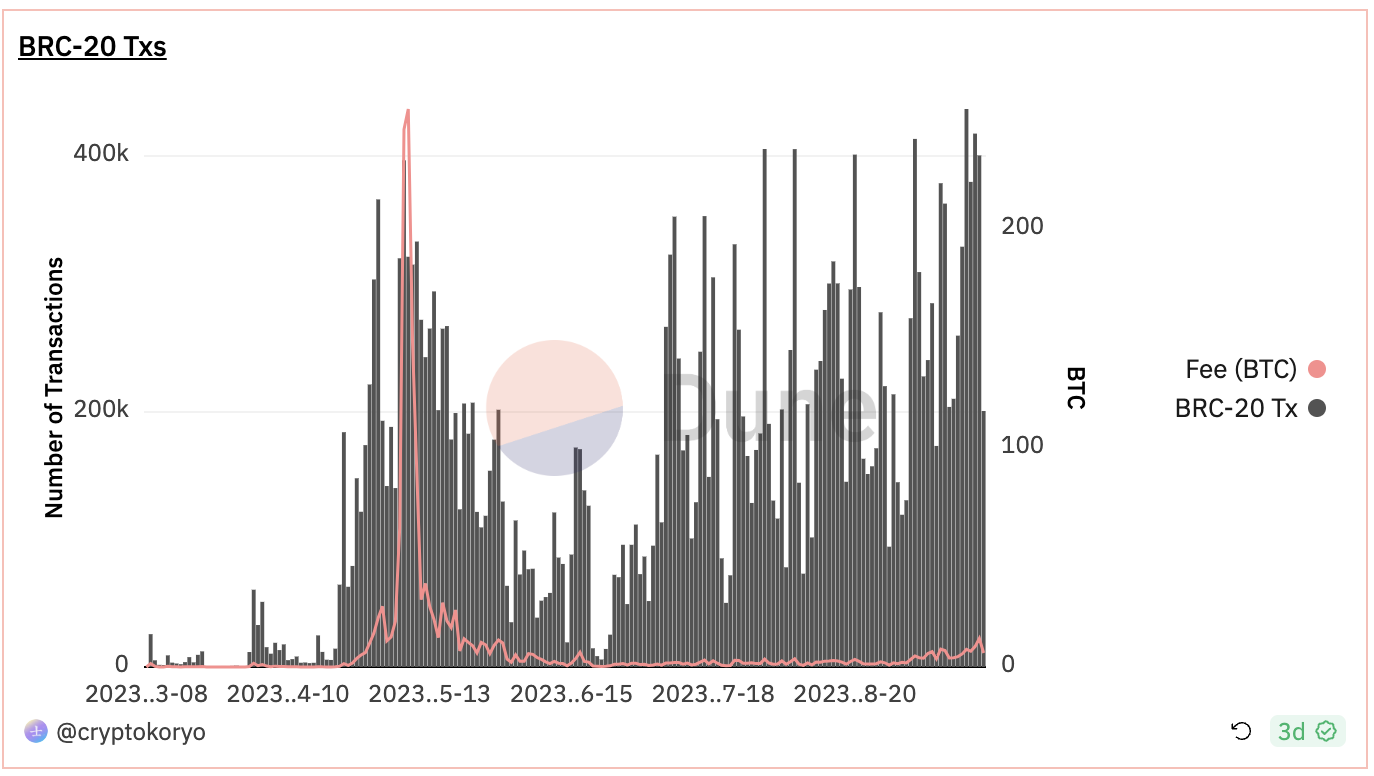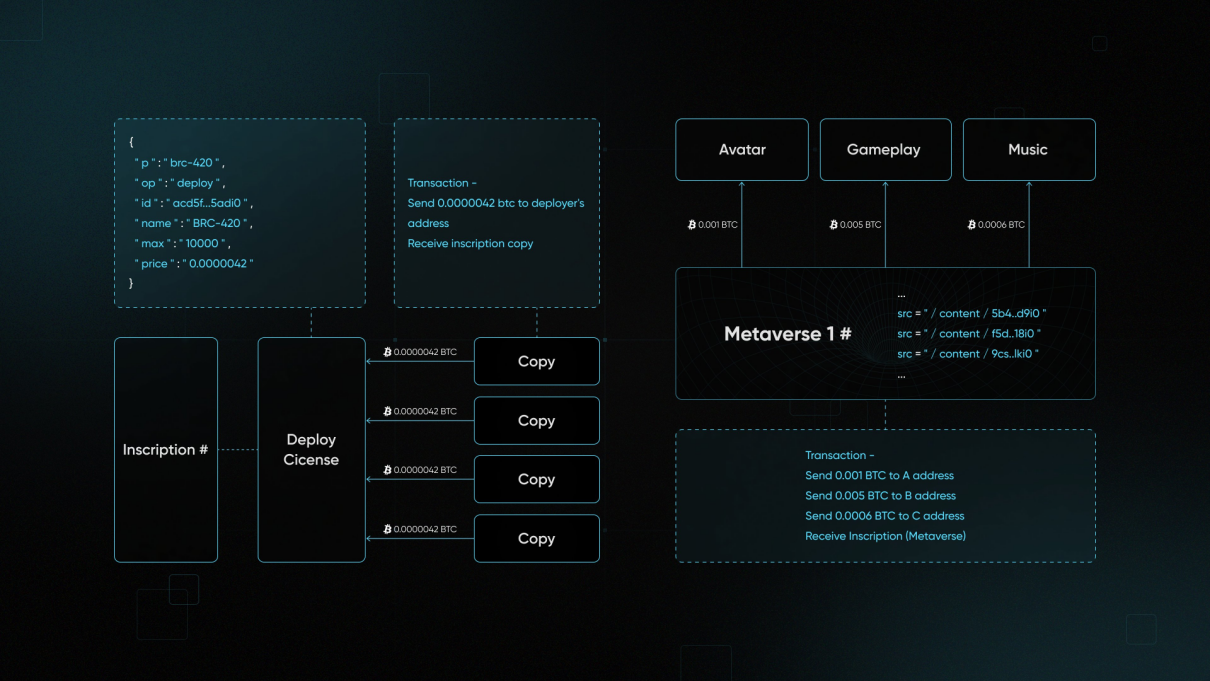The Ordinals ecosystem after the "passion fades": An overview of the development status of various protocols
Written by: Misty Sea, PANews
Looking back over the past six months, the Bitcoin Ordinals ecosystem has evolved from its nascent stage at the beginning of the year to a flourishing phase from March to May, followed by a more subdued sentiment. Market sentiment has shifted from the previously firm prediction that Ordinals would be the engine of a new bull market to a current state of skepticism and confusion.
However, a real fact is that the development of the Ordinals ecosystem has never paused. Many new protocols and projects based on Ordinals have emerged during this time. For example, the newly launched brc420 and arc20 in the past two days have attracted widespread attention and discussion in the inscription ecosystem with opening prices more than ten times their cost.
In this article, PANews will provide users with a detailed explanation of the current development status of various new protocols within the Ordinals ecosystem and better ways to participate.
Brc20: Deploying Token Contracts on the Bitcoin Chain, Continually Active
On March 8, 2023, domo proposed using JSON data format Ordinals inscriptions to deploy token contracts, mint coins, and transfer, leading to the birth of the Brc20 protocol. Its first token, ORDI, surged to over ten thousand times its relative cost, allowing Ordinals to break into the mainstream.
According to Dune data, as of September 23, the Brc20 protocol has generated 28.6 million transactions, resulting in transaction fees of 1,590 Bitcoins, equivalent to 42.4 million USD. Observing with ORDI as an index, its peak daily trading volume exceeded 100 million USD, and it has currently dropped to a minimum of 8 million USD.
Since its inception, the Brc20 protocol has seen close attention from community users, but there have been almost no technical updates or iterations. The only significant progress is that unisat, which integrates wallet, inscription, and trading market, is developing brc20-swap in hopes of improving the current liquidity shortage of brc20 tokens.

Orc20: Making Brc20 More Flexible, No Updates
Orc20 was created by OrcDAO to enhance some key features of BRC20, improving adaptability, scalability, and security while eliminating the possibility of double spending.
Its official documentation mentions updates OIP 1-11 to improve the Orc20 protocol, but since late July, OrcDAO's official Twitter has stopped updating, and there has been no further progress. According to Dune data, the Orc20 protocol has generated 370,000 transactions, consuming transaction fees worth 24 Bitcoins since its inception to its silence.
Bitmap: Bitcoin Chain Metaverse, Over 20,000 Addresses
The developer of the Bitmap protocol is blockamoto. This protocol aims to utilize Ordinals and Bitmap theory to construct a metaverse based on the Bitcoin chain, allowing anyone to inscribe spatial assets of Bitcoin blocks, with the distribution process being decentralized and fairly distributed.
After the protocol was launched, Ordinalswallet officially developed a Bitmap-based map for duplication checking and inscription. Later, developers built bitmap.land as a portal for the Bitmap protocol, along with tools and documentation like bitmap-directory. Additionally, projects continue to emerge based on the Bitmap protocol.
As of now, the incomplete statistics of the Bitmap map show a transaction volume of 120 Bitcoins, with over 22,000 holding addresses. Community discussions are more rational, mainly focusing on how to expand and enrich the Bitmap protocol.

gBRC721: Optimizing Block Space, Lacking Follow-Up
The gBRC721 protocol, fully named generative-brc-721, was developed by 0x Jerry 543, who is also the initiator of the Bitcoin NFT project DogePunks. This protocol aims to save on-chain resources, achieving 50%-90% optimization of block space to accommodate more creators and promote innovation.
The protocol gained attention due to its ecological project OrdiBots, which saw a relative cost increase of a thousand times. The representative project OrdiBots has a total trading volume of 37 Bitcoins, with 550 holding addresses, and has yet to be parsed and displayed by Magiceden. Initially, community enthusiasm was extremely high, but due to a lack of follow-up, the protocol has not seen further applications, and the community has fallen silent.
Recursive Inscription: Making the Metaverse Run on Bitcoin Possible, Current Status Grim
Recursive inscriptions were proposed by Ordinals creator Casey Rodarmor. The intention is to allow inscription sizes to break the Bitcoin block size limit of 4MB, enabling complex 3D video games to be fully on-chain on Bitcoin. This led the community to believe that smart contracts similar to ERC20 might run on the Bitcoin chain, thus making scalability and interoperability on the Bitcoin chain possible.
Although market attention and sentiment have surged, few developers have used recursive inscriptions to build projects, and most have merely replicated existing projects for improvement.
In terms of price increase and trading volume, the representative projects Recursive Punks and Recursive Frogs combined have only seen a trading volume of 30 Bitcoins. Currently, the community hardly mentions recursive inscriptions, and no projects are continuously operating.
Trac: Decentralized Index for Ordinals, A Rising Star
The developer of the Trac protocol is Beny, aimed at solving the unresolved issue of decentralized indexing in the current inscription ecosystem. Due to its innovative concept and addressing community pain points, its governance token TRAC has performed excellently in the secondary market, with a relative cost increase of over a hundred times, and its trading volume has reached 2.1 million USD. Trac has already collaborated with projects like Bitmaps and Inscribed Handles.
Subsequently, Beny developed the Tap protocol, which serves as an Ordinals service enabling protocol. The tokens of this protocol have different functions, including transfer confirmation mechanisms, batch transfers, and the ability to set token names from 3 to 32 characters, allowing developers to create their tokens more flexibly. The representative token of this protocol, TAP, has also performed reasonably well in the over-the-counter market.
Last week, the Tap protocol launched new features for "token-auth" specifications and indexing, allowing third parties to authorize sending tokens from authorized wallets. This supports games, metaverses, token bridges, cross-chain markets, and more on the TAP protocol.
ORC-CASH: A Token System Like a Cash System
The creator of the ORC-CASH protocol is Sonic, who intends to implement a token system on the UTXO network similar to a cash system. The first token of this protocol, OSH, rose to a peak of 100 USD after inscription, with a trading volume of 10 Bitcoins on the Magiceden platform, excluding initial over-the-counter trading volume.
Observations show that since the ORC-CASH protocol's inception, developers have been actively developing and operating, from indexing to market listing, proceeding in an orderly manner. The community also shows reasonable engagement, discussing and exchanging from a developmental perspective, and occasionally proposing and voting on on-chain proposals. Recently, its creator Sonic attended the Singapore 2049 conference to communicate with Ordinals ecosystem developers.
Brc420: Endowing Inscriptions with Royalty Functions
The initiator of Brc420 is Recursiverse, which emerged during the recursive inscription period. Brc420 defines a more complex asset format through recursion and is fully open-source, allowing anyone to create their own metaverse inscriptions. At the same time, Brc420 establishes a constraint relationship between usage rights and royalties based on a single inscription. When a user owns an inscription, they can allocate its usage rights and set a price, which can incentivize more innovation within the Ordinals ecosystem.
The first experimental token of the Brc420 protocol has also been launched, and the enthusiasm in the over-the-counter market is reasonable. Its initiator, Recursiverse, continues to expand its ecosystem, collaborating with many protocols and projects within the Ordinals ecosystem. According to official information, it has also sponsored the recent Singapore Ordinals Summit.

Arc20: The Simplest and Most Powerful Way to Create Digital Objects on Bitcoin
The Arc20 protocol addresses how to represent any fungible token asset on the Bitcoin blockchain. The ARC20 fungible token standard ultimately brings colored coins to Bitcoin, using 1 satoshi to represent ownership units of deployed tokens. This means that the value of each token will never be less than 1 satoshi.
The project's Twitter has been operational since late May 2023, and it was only recently discovered by the community and began minting. Since the minting method for Arc20 protocol tokens is through GPU mining, it requires a certain technical threshold. Despite this, the community still managed to mint the first token ATOM of the Arc20 protocol in just one day.
After the minting of ATOM, over-the-counter trading surged. Its opening price rose to 30 USD each, briefly stayed at 50 USD, then jumped to 100 USD, and has now fallen back to around 80 USD. The range of attention it has garnered and the FOMO sentiment have swept through the previously quiet Ordinals ecosystem, with users mentioning the Arc20 protocol across social media and various communities. Whether it can sustain operations, like many previous protocols, remains to be seen after a wave of hype.
Conclusion
According to data analysis platform geniidata, as of September 23, over 33.9 million inscriptions have been generated, with over 600,000 addresses holding inscriptions, resulting in nearly 45 million transfers and transactions. According to Dune data, the transaction fees generated by the Ordinals ecosystem have also exceeded 2,000 Bitcoins, equivalent to 53 million USD.
From the above, it can be seen that since its inception, the Ordinals ecosystem has gradually calmed down after experiencing peak attention and funding across the network. From an investment perspective, every new protocol, regardless of its outcome, has experienced a wave of FOMO after launching on the secondary market. Therefore, one can look for projects with new protocols and zero or low-cost inscriptions, then enter at low costs and gradually sell off during the FOMO period in the secondary market.
Additionally, new protocols and projects within the ecosystem continue to emerge, with developers constantly improving and users not hesitating to focus on and inject funds into new protocols. In the long run, the Ordinals ecosystem is also worth paying attention to.










